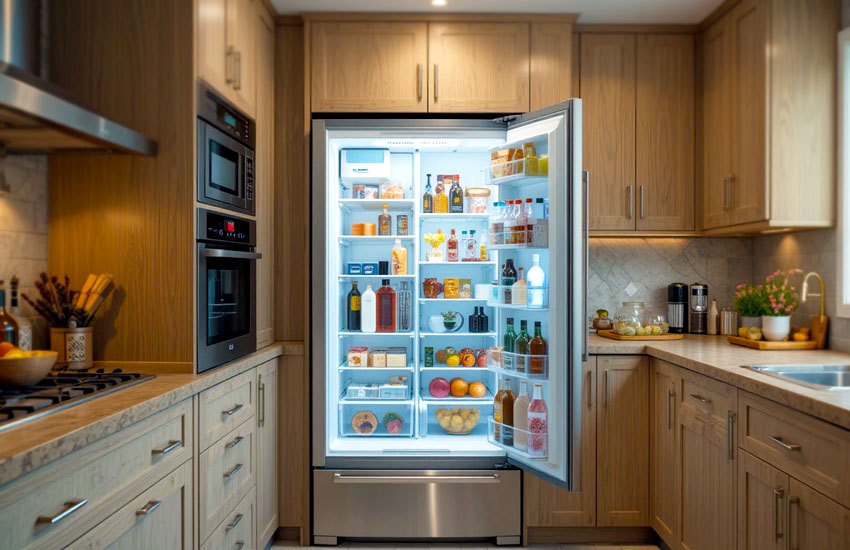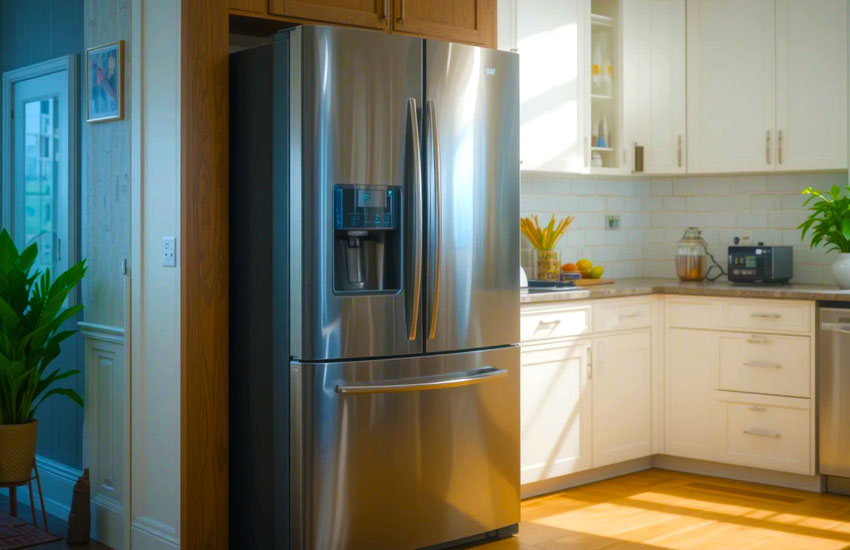As an Amazon Associate, I earn from qualifying purchases at no extra cost to you.
6 Essential Tips for Maintaining Your Refrigerator
Your refrigerator works hard every day to keep your food fresh, but how often do you think about its upkeep? Neglecting maintenance can shorten its life and lead to costly repairs. In this guide, we’ll explore ten essential tips for maintaining your refrigerator so it stays in top shape, saving you money and headaches.

1. Clean the Condenser Coils
Cleaning your refrigerator’s condenser coils is one of the most critical maintenance tasks. These coils are usually located either at the back or underneath the fridge. Over time, dust and debris can build up, reducing the efficiency of your fridge and making it work harder to keep things cool.
Why clean the coils?
The condenser coils are responsible for releasing heat from the fridge. When they are clogged with dirt, the heat can’t escape efficiently. This puts strain on the compressor, leading to increased energy usage and potential overheating.
How to clean them
- Unplug your refrigerator for safety.
- Locate the coils; consult your fridge’s manual if unsure.
- Use a vacuum with a brush attachment to remove the dust.
- For stubborn dirt, gently wipe with a damp cloth.
- Plug your fridge back in and ensure it’s cooling properly.
How often?
Aim to clean the coils every six months, or more often if you have pets that shed hair.
2. Check and Replace Door Seals
The door seals, or gaskets, play a vital role in keeping the cool air inside your refrigerator. Damaged or dirty seals can allow air to escape, causing your fridge to work overtime and increasing your energy bills.
How to inspect the seals
- Look for cracks, tears, or visible dirt on the seals.
- Perform the “dollar bill test”: Close a dollar bill in the door. If it slips out easily, the seal may need attention.
Cleaning and replacing
- Clean the seals with warm, soapy water and a soft cloth.
- If cleaning doesn’t improve the seal, consider replacing it. You can usually order a replacement seal online and install it yourself.
Frequency
Check the seals every three months to ensure they’re in good condition.
3. Maintain the Right Temperature
Keeping your refrigerator and freezer at the correct temperature is essential for food safety and energy efficiency.
What are the ideal settings?
- Refrigerator: 37-40°F (3-4°C)
- Freezer: 0°F (-18°C)
Why it matters
If your fridge is too warm, food can spoil faster. If it’s too cold, you risk wasting energy and freezing items that shouldn’t freeze. Maintaining the right temperature ensures your fridge operates efficiently.
How to monitor temperatures
- Use an appliance thermometer for accurate readings.
- Adjust the settings as needed, especially during seasonal changes.
Additional tips
Keep your fridge well-stocked, but not overcrowded, to allow proper air circulation. If your fridge is often empty, consider adding bottles of water to help stabilize the temperature.
4. Organize the Contents
Properly organizing your refrigerator not only makes it easier to find items but also helps maintain consistent temperatures and reduces energy consumption.
Why organization matters
Poor organization can block air vents, leading to uneven cooling. Additionally, expired or forgotten items can rot and create unpleasant odors.
Tips for organizing
- Store raw meat on the bottom shelf to prevent cross-contamination.
- Use clear containers to store leftovers and prevent waste.
- Keep frequently used items at eye level.
- Avoid placing warm or hot food directly into the fridge.
- Clean spills immediately to avoid stains and odors.
Regular cleaning
Set a reminder to clean out your fridge weekly. Discard expired items and wipe down shelves with a mild cleaner.
5. Defrost the Freezer (If Needed)
If your refrigerator isn’t frost-free, regular defrosting is crucial to prevent ice buildup, which can reduce efficiency and storage space.
Why defrost?
Excessive frost can block airflow, making it harder for your freezer to maintain the right temperature.
How to defrost
- Empty the freezer and transfer food to a cooler.
- Unplug the refrigerator and leave the freezer door open.
- Use towels to soak up melting ice.
- Once the ice has melted, wipe down the interior with a clean cloth.
- Plug the fridge back in and allow it to cool before restocking.
Frequency
Defrost whenever the ice buildup exceeds ¼ inch (0.6 cm).
6. Keep the Refrigerator Level
A level refrigerator is essential for proper functioning. If it’s tilted, the doors may not close completely, and the compressor may strain to operate efficiently.
How to check if it’s level
Place a carpenter’s level on the top of the fridge. If it’s uneven, adjust the leveling legs, which are located at the bottom.
Steps to level your fridge
- Empty the fridge to make it lighter.
- Locate the leveling legs or wheels.
- Use a wrench to adjust the legs until the fridge is level.
- Check the door alignment to ensure it closes tightly.
How often?
Check the level every few months or after moving the fridge.
I hope these tips help you keep your refrigerator running smoothly for years to come. Regular maintenance not only saves energy but also prevents costly repairs and extends your fridge’s lifespan. A little effort now can go a long way toward preserving your appliance.

Are These Questions in Your Mind?
Is it safe to clean my refrigerator while it’s plugged in?
Unplugging the fridge is recommended for safety, especially when cleaning near electrical components.
Can I use regular soap to clean the interior?
Yes, but ensure it’s mild and rinse thoroughly to avoid leaving residue.
Do I need professional help to replace door seals?
No, most seals are easy to replace with basic tools and instructions.
Is it normal for the fridge to make noise?
Some noise is normal, but loud or unusual sounds may indicate a problem.
Can I store hot food in the refrigerator?
It’s better to let hot food cool slightly before storing to prevent temperature fluctuations.
Is it okay to turn off the fridge when not in use?
If you won’t use the fridge for an extended period, empty it, clean it, and leave the door slightly open.
Do I need to clean the drip pan?
Yes, clean the drip pan annually to prevent odors and mold.
Can a refrigerator run in a cold garage?
Many fridges struggle in cold environments; check the manufacturer’s recommendations.
Is frost buildup in the freezer a sign of a problem?
Frost can indicate a sealing issue or overloading; check the door seal and defrost if necessary.
Do I need a professional to fix a noisy compressor?
Yes, a noisy compressor often requires expert attention.